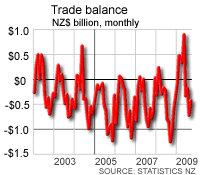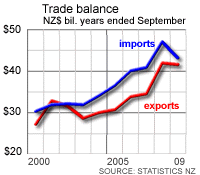 New Zealand's trade deficit widened by more than expected in August from July, although the deficit was still less than in August 2008 as merchandise imports fell by more than merchandise exports over the year, figures released by Statistics New Zealand show. (Update 3 includes economist comment.) New Zealand's merchandise trade deficit was NZ$725 million in August, from a revised NZ$175 million deficit in July (from NZ$163 million) and compared to an NZ$848 million deficit in August 2008. Merchandise exports were down NZ$830 million, or 23.2% from a year ago, while merchandise imports fell by NZ$953 million, or 21.6%.
New Zealand's trade deficit widened by more than expected in August from July, although the deficit was still less than in August 2008 as merchandise imports fell by more than merchandise exports over the year, figures released by Statistics New Zealand show. (Update 3 includes economist comment.) New Zealand's merchandise trade deficit was NZ$725 million in August, from a revised NZ$175 million deficit in July (from NZ$163 million) and compared to an NZ$848 million deficit in August 2008. Merchandise exports were down NZ$830 million, or 23.2% from a year ago, while merchandise imports fell by NZ$953 million, or 21.6%.
 Economist expectations had centred around the mark of a NZ$300 million deficit, although BNZ had picked a NZ$766 million shortfall. In the year to August 2009, New Zealand recorded a trade deficit of NZ$2.37 billion, compared to a NZ$4.37 billion deficit in the year to August 2008. Exports were up 0.5% from the 2008 August year, while imports fell 3.9%. The 2009 year recorded the smallest deficit for an August year since the year ended August 2002 (NZ$183 million deficit). The trade balance for the August 2009 month represented 26.4% of the value of exports, compared to an average August deficit of 34.1% of exports for the previous five years. The fall in exports between the months of August 2008 and 2009 was the largest annual fall in exports since March 1986, Stats NZ said, although there had been a large jump in exports in August 2008. "Exports in August 2009 are back to a level similar to August 2007, before the large value rises observed in dairy and crude oil exports in the latter half of 2007 and during 2008," Stats NZ said.
Economist expectations had centred around the mark of a NZ$300 million deficit, although BNZ had picked a NZ$766 million shortfall. In the year to August 2009, New Zealand recorded a trade deficit of NZ$2.37 billion, compared to a NZ$4.37 billion deficit in the year to August 2008. Exports were up 0.5% from the 2008 August year, while imports fell 3.9%. The 2009 year recorded the smallest deficit for an August year since the year ended August 2002 (NZ$183 million deficit). The trade balance for the August 2009 month represented 26.4% of the value of exports, compared to an average August deficit of 34.1% of exports for the previous five years. The fall in exports between the months of August 2008 and 2009 was the largest annual fall in exports since March 1986, Stats NZ said, although there had been a large jump in exports in August 2008. "Exports in August 2009 are back to a level similar to August 2007, before the large value rises observed in dairy and crude oil exports in the latter half of 2007 and during 2008," Stats NZ said.
After rising steadily from mid-2007, the trend for total merchandise exports has been declining from its peak in October 2008 and is down 10.5 percent since then. The level of the trend is now comparable to what it was in November 2007. This is the biggest fall seen in the trend since the 16.5 percent fall that occurred from June 2001 to June 2003. Crude oil showed the largest decrease in August 2009 (from August 2008), down $177 million (50.9 percent), mainly due to lower prices. Meat and edible offal was the next largest fall, down $125 million (32.2 percent), led by exports of frozen beef and sheep cuts. Overall quantities of meat and edible offal were down about one-third from August 2008. Despite overall quantities being almost 30 percent higher, milk powder, butter and cheese fell $118 million (24.8 percent) with whole milk powder, anhydrous milk fat, natural milk constituents and salted butter being significant contributors. By comparison, increases in exports were fewer and smaller for the month of August 2009, with fruit showing the largest increase, up $11 million (7.8 percent), led by kiwifruit up $8 million (5.8 percent). By country of destination, the largest fall in exports was to Australia, down $296 million (28.0 percent) led by exports of crude oil, down $180 million. Exports to the United States of America were the next most significant decrease, down $122 million (40.7 percent), with exports of meat and edible offal down $51 million, led by bovine cuts, down $38 million. Exports to Japan were the third largest decrease, down $93 million (27.8 percent), with crude oil a significant contributor (down $46 million), as no crude oil was exported to Japan in August 2009. Aluminium exports were the next largest contributor, down $31 million. The largest increase in exports in the month of August 2009 were those to the People's Republic of China, up $37 million (19.9 percent). This increase was led by wood exports, which were up $30 million (led by pinus radiata logs), and milk powder, butter and cheese, up $12 million (led by whole milk powder).
Stats NZ said excluding one-off imports, import values have now fallen by 19 percent or more for each of the last five months, when compared with the same month of the previous year.
The trend for merchandise imports has been decreasing since peaking in August 2008, and is down 20.7 percent since then. This is the largest fall in the imports trend since the series began in 1988. All of the main broad economic categories were down in August 2009 compared with August 2008, except for consumption goods which remained virtually unchanged. Petroleum and products recorded the largest decrease, down $424 million (45.1 percent). This fall was led by crude oil...Crude oil is imported in large, irregular shipments, which can give rise to large fluctuations in quantities and values. Vehicles, parts, and accessories was the next largest decrease, down $151 million (34.3 percent), as imports of passenger motor cars fell by $71 million (26.6 percent) and goods transport vehicles fell by $52 million (64.5 percent). By comparison, increases in imports were fewer and smaller, the largest being optical, medical and measuring equipment, up $23 million (21.2 percent), and pharmaceutical products, up $10 million (11.4 percent). By country of origin, the largest decrease in imports came from Australia, down $261 million (30.0 percent), mainly due to a fall in crude oil; vehicles, parts and accessories (mainly passenger cars); and iron and steel. The largest increase in imports by country of origin came from Singapore, up $79 million (76.6 percent) mainly due to an increase in refined or partly refined petroleum products.
ASB economist Jane Turner said the surprising weakness in the August deficit was solely from exports, with imports coming out "bang on expectations."
The trade surpluses NZ enjoyed over the first half of 2008 are now coming to an end. The seasonal wind down of agricultural exports has revealed the underlying weakness in export demand, in particular the weakness in export prices. Dairy volumes are likely to remain subdued this year, as low returns will discourage additional expenditure by farmers to increase volumes. Meat volumes could also prove subdued as farmers may choose to focus on herd-rebuilding. Manufacturing export volumes have already fallen considerably, and may now start to stabilise along with world demand. However, the relative strength in the NZ dollar will continue to put pressure on export returns. Today's disappointing trade balance follows a string of positive economic news last week, including the decline in the current account deficit, Fonterra's payout revision and the early recovery of the NZ economy. The weakness in August's export receipts serves as a reminder of how fragile New Zealand's economy recovery remains. We still expect positive GDP growth in the second half of this year, although it will be very weak growth and more a case of the economy stabilising rather than expanding.

We welcome your comments below. If you are not already registered, please register to comment
Remember we welcome robust, respectful and insightful debate. We don't welcome abusive or defamatory comments and will de-register those repeatedly making such comments. Our current comment policy is here.